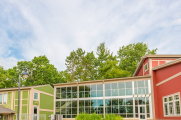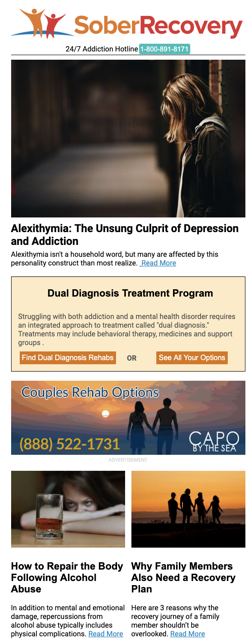Hallucinogens and Shamanism: A Brief Article Clinton IA
(563) 243-2124
Services Provided
Substance abuse , Halfway house
Types of Care
Residential short-term treatment (30 days or less), Residential long-term treatment (more than 30 days)
Special Programs/Groups
Men

Substance abuse
Types of Care
Outpatient
Special Programs/Groups
Adolescents, Persons with co-occurring mental and substance abuse disorders, Women, Men, DUI/DWI offenders, Criminal justice clients

Substance abuse
Types of Care
Outpatient
Special Programs/Groups
Adolescents, Persons with co-occurring mental and substance abuse disorders, DUI/DWI offenders, Criminal justice clients
Language Services
ASL or other assistance for hearing impaired

Substance abuse
Types of Care
Outpatient
Special Programs/Groups
Persons with co-occurring mental and substance abuse disorders, DUI/DWI offenders

Substance abuse , Detoxification
Types of Care
Outpatient
Special Programs/Groups
Men

(563) 242-2042
Services Provided
Substance abuse , Halfway house
Types of Care
Residential long-term treatment (more than 30 days), Outpatient
Special Programs/Groups
Women, Residential beds for clients' children, Criminal justice clients
Language Services
ASL or other assistance for hearing impaired

Substance abuse
Types of Care
Outpatient
Special Programs/Groups
Adolescents, Pregnant/postpartum women, Women, Men, Criminal justice clients
Language Services
ASL or other assistance for hearing impaired

Mount Pleasant, IA
(319) 385-2216
Services Provided
Substance abuse
Types of Care
Outpatient
Special Programs/Groups
Adolescents, Pregnant/postpartum women, DUI/DWI offenders

(563) 589-8280
Services Provided
Substance abuse , Detoxification
Types of Care
Hospital inpatient, Outpatient
Special Programs/Groups
Adolescents

Substance abuse
Types of Care
Outpatient
Special Programs/Groups
Adolescents, Persons with co-occurring mental and substance abuse disorders


Hallucinogens and Shamanism: A Brief Article
In the western area, many drugs are highly refined and attempted excessively or habitually, in ways that are addictive and harmful. However, in traditional societies powerful mind-active plants are consumed ritually for therapeutic purposes or for transcending normal, everyday reality. In this article I will look in detail at the ritual use of mind-active drugs for therapeutic mind-expansion as part of shamanic traditions in comparison to the modern abuse of pharmaceutical drugs as part of drug addictions and dependencies.
The use of psychoactive drugs was studied in the 1960s by Timothy Leary and Richard Alpert who looked at LSD and psilocybin who studied shamanic teachings and practices around the globe. These shamanic traditions involve non-ordinary states of consciousness induced by a variety of methods including ingesting hallucinogenic plants, but also drumming, fasting, wilderness vision questing, use of sweat lodges and others.
Metzner notes that indigenous people have a profound knowledge of plants and herbs and their effects on the body and mind and are well able to distinguish harmful from beneficial medicines. For this reason the vision-inducing plants that have a tradition of shamanic usage are much more likely to be safe, in contrast to newly discovered and synthesized drugs, the use of which may often involve unknown long-term risks.
Western psychotherapy and indigenous shamanism use similar psychoactive substances for healing and obtaining knowledge (call...
Click here to read the rest of this article from Sober Recovery
Featured Facilities
Compassionate care for individuals with opioid and alcohol use disorders. Substance use disorders are a leading cause of death, incarceration, hospitalizations, motor vehicle crashes, and numerous medical complications such as hepatitis C and HIV. We are passionate about recovery, and strive to help each patient achieve their own recovery from substance use disorders is a lifelong journey which begins with education, medical optimization, and accountability.We are proud to serve Texas as the Top Houston Suboxone Doctor and the surrounding areas with In-Office and Virtual Visit Appointments! He provides Concierge-level compassionate care for individuals with Opioid and Alcohol Use Disorders and believes treatment for addiction works to help individuals maintain long-term abstinence and recovery.With Dr. Giannotti, appointments are zero-wait, always on time as he specializes in services and treatments such as:- Anxiety treatment- Depression treatment- Insomnia treatment- Medication Assisted Treatment (MAT)Sometimes the smallest step in the right direction ends up being the biggest step in one's life. Tip Toe if you must, but Dr. Giannotti is here to take the step beside you.
At Skywood, we are deeply invested in helping you regain your health. Our programming approach to recovery is designed with that in mind, from individual and group therapy to adventure therapy, art therapy and yoga. Each of these activities builds on the others to get to the root causes of addiction, introduce healthy new habits, address any co-occurring mental health issues and provide the mental and physical space you need in order to heal. We also provide access to regular 12-Step meetings and peer support groups. What we do at Skywood is different for several reasons. First, we treat addiction and mental health at the same time in a highly integrated way, looking to restore a person’s physical, emotional, mental and spiritual well-being. Second, we focus on resolving trauma, underlying issues and deep-rooted emotional pain that often causes substance abuse in the first place. Lastly, we emphasize life skills that help each person build a foundation for sustainable, long-term recovery.
Located in Orange County, California, Connections Mental Health is a residential treatment center that focuses on treating a range of mental health conditions. It treats a maximum of 6 clients at a time to create individualized care. With compassion at the core of its approach, the team provides a comprehensive evaluation before treatment to customize clients’ care plans to meet a diversity of needs.Mental Health Treatment Connections Mental Health can help those with depression, anxiety, post-traumatic stress disorder (PTSD), bipolar disorder, borderline personality disorder (BPD), obsessive-compulsive disorder (OCD), schizophrenia, attention-deficit/hyperactivity disorder (ADHD), and suicidal and homicidal ideation. Connections Mental Health additionally has a 24/7 supervised eating disorder program backed by a team of psychiatrists, psychologists, dietitians, and medical doctors. They offer a special program for people with premenstrual dysphoric disorder (PMDD).Comprehensive TherapiesConnections Mental Health uses 1:1, group, and family-based therapy (FBT) to help clients recover. FBT restores healthy habits and builds open communication within the family. They offer evidence-based therapies such as cognitive behavioral therapy (CBT), dialectical behavioral therapy (DBT), eye movement desensitization and reprocessing (EMDR), and motivational interviewing. Connections Mental Health offers medication management based on their clinical assessment. They incorporate the Seeking Safety program into treatment. Seeking Safety creates a safe space to develop coping skills, emotion regulation, and resilience through therapies that focus on healing current feelings and behaviors, not past ones.Holistic HealingConnections Mental Health utilizes holistic tools as part of their rehab process like yoga, mindfulness, and meditation, and other modalities like art therapy, to complement the recovery process. These therapies can help clients develop coping strategies, reduce stress, and improve overall well-being. Connection Mental Health’s Orange County residential home has a backyard with comfortable seating and a firepit.
Lake Ariel Recovery Center, like all of the Sanctuary Health Group facilities, is a medically proven recovery facility that provides comprehensive treatment for substance use and co-occurring disorders. Sanctuary Health utilizes Everlasting Recovery, an approach that aligns our client’s recovery journey directly with their life, to extend recovery into a client’s lifestyle. Our unique approach establishes treatment as a daily practice, refocuses an individual away from addiction towards a healthier existence, and makes sustainable recovery achievable. Due to this integration, each client begins Everlasting Recovery by assessing their performance in various aspects of their lives via the bio, psycho, and social model. This initial assessment allows our therapists to craft a personal recovery program, which allows the greatest opportunity for our clients to suppress addiction and adopt recovery as a permanent identity. When attending Lake Ariel Recovery Center, our clients will establish life skills, implement daily routines for lifestyle recovery, and ignite a purpose for achieving better their lives. Through accomplishing these tasks, our clients will achieve sustainable recovery.




